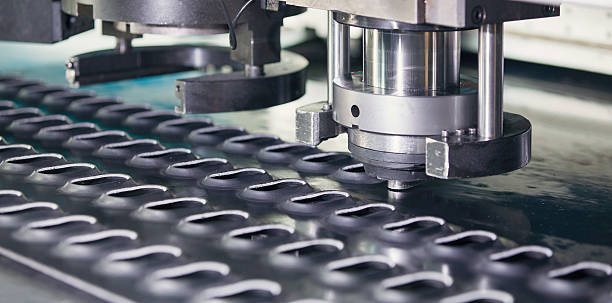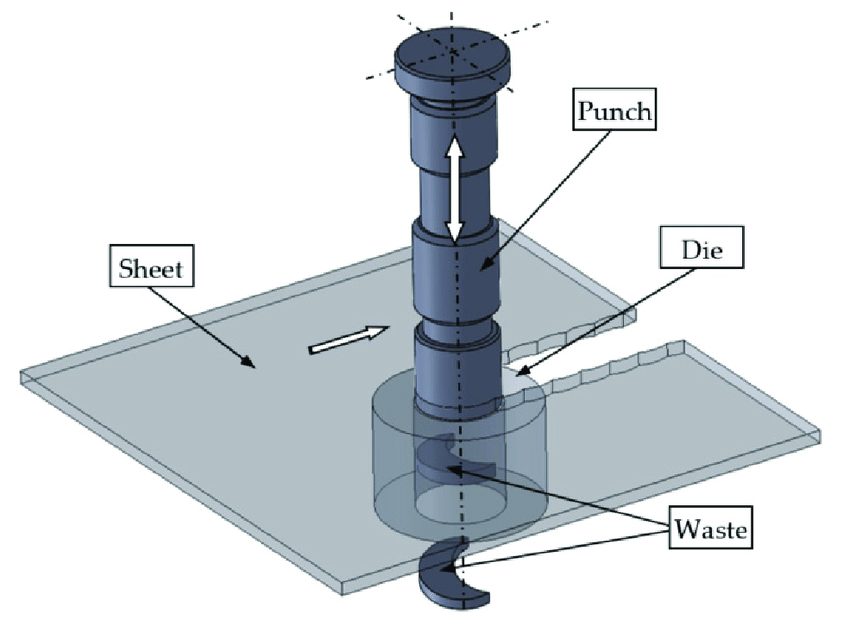
In the dynamic world of sheet metal manufacturing, flexibility and precision are paramount. The nibbling process often emerges as the method of choice for applications that demand intricate shapes and designs. But how does this process work? What steps does it involve, and what factors must be considered to ensure successful nibbling operations?
This comprehensive guide’ll delve into these questions and more, offering a detailed, step-by-step walkthrough of the nibbling process.
Understanding the Nibbling Process

Metal perforating industrial machine.
When exploring the world of sheet metal manufacturing, one encounters several techniques designed for specific tasks, one of which is the nibbling process.
The nibbling process is a shearing process employed in the manufacturing industry to make a series of minor, overlapping cuts or “nibbles” to form a desired shape or design in a workpiece.
Process Overview

What is the nibbling process? A specially designed punch moves up and down, removing small bits of metal with each stroke to form the desired contour. The punch can move in any direction around the sheet, enabling it to create various shapes and patterns. The machine’s swift and precise movements result in a clean cut with little material deformation.
Nibbling Vs. Other Cutting Techniques
In the vast spectrum of metal cutting techniques, each has its unique set of benefits and limitations. Here’s a quick comparison between nibbling and other cutting techniques:
| Cutting Technique | Speed | Precision | Versatility | Best Use |
|---|---|---|---|---|
| Nibbling | Medium | High | High | Complex shapes, patterns |
| Laser Cutting | High | Very High | Medium | High-volume production |
| Plasma Cutting | High | Medium | Low | Large, thick materials |
Step 1: Selecting the Appropriate Material
Material selection is a pivotal step in ensuring a successful nibbling process. Different materials react differently to nibbling, affecting the quality of the finished product.
Nibbling is a versatile process that can be used on various materials. It’s most commonly employed for sheet metal but is also effective with other materials, including plastic and circuit boards.
However, the material’s hardness and thickness can affect the ease of nibbling and the quality of the finished product. Therefore, ensuring that the chosen material is compatible with the nibbling process is crucial.
Related:Exploring the Wide Range of Machinable Options for CNC Machines
Considerations for Material Thickness
When it comes to material thickness, nibbling is generally most effective with medium-thickness sheet materials. The table below illustrates some suitable material thickness ranges for nibbling:
| Material Type | Suitable Thickness Range (mm) |
|---|---|
| Steel | 0.5 – 3.0 |
| Aluminium | 0.5 – 6.0 |
| Plastic | 0.5 – 10.0 |
Evaluating Material Quality
The quality of the material also plays a significant role in the nibbling process. Materials with imperfections such as cracks, rust, or inclusions can affect the nibbling process’s accuracy and efficiency, leading to a sub-par final product. Therefore, it’s crucial to inspect the material for any such imperfections before starting the nibbling process.
Step 2: Preparing the Design for Nibbling
This step revolves around creating an accurate and detailed design that will guide the nibbling machine. The overall quality of the final product highly depends on the accuracy and precision of the initial design.
- Conceptualizing the Design
The first phase in preparing the design involves conceptualizing the final product. Designers and engineers work together to create a model that meets the product’s requirements in terms of functionality and aesthetics.
- Creating the CAD Design
After conceptualization, the design is then transferred into a Computer-Aided Design (CAD) system. The CAD system is used to generate a precise 3D model of the product, which can be manipulated and viewed from different angles.
- Transferring the CAD Design to the Machine
Once the CAD design is finalized, it is then transferred to the nibbling machine. Modern nibbling machines use computer numerical control (CNC) technology, which allows the machine to be directly guided by the CAD design.
Table. Steps in preparing the design for nibbling
| Step | Description |
|---|---|
| Conceptualizing the Design | Brainstorming and sketching the design. |
| Creating the CAD Design | Transferring the design to a CAD system for a precise 3D model. |
| Transferring the CAD Design to the Machine | Using CNC technology to guide the nibbling machine based on the CAD design. |
Try Prolean Now!
Step 3: Setting Up the Nibbling Machine
Setting up the nibbling machine correctly is a crucial step in the nibbling process. This stage requires careful attention to detail to ensure the machine operates as intended.
- Choosing the Appropriate Punch and Die
Different materials and designs require different types of punches and dies. Selecting the correct punch and die for the job is crucial for achieving a precise and clean cut. The decision will largely depend on the thickness and the hardness of the material.
- Adjusting the Machine Settings
The nibbling machine settings must be adjusted to suit the specific job at hand. This can include adjusting the speed of the machine, the force of the punch, the overlap of the cuts, and the feeding rate of the material.
Table. Considerations for setting up the nibbling machine
| Setting | Description |
|---|---|
| Punch and Die Selection | Based on the material’s thickness and hardness. |
| Speed | Determined by the machine’s capabilities and material properties. |
| Force | Must be sufficient to cut the material without causing damage. |
| Overlap | Dictates the precision of the nibbling process. |
| Feeding Rate | Controls the material flow into the machine. |
Step 4: Running the Nibbling Process
With the machine set up and the design loaded, the next step is to initiate the nibbling process.
- Process Execution
Running the nibbling machine involves starting the machine and monitoring its operation. It’s crucial to watch the machine during the nibbling process to ensure it operates correctly and to intervene if any issues arise.
Table: Considerations During Process Execution
| Factor | Description |
|---|---|
| Machine Operation | Regularly monitor the machine’s operation for signs of wear or malfunction |
| Quality of Cuts | Continually inspect the quality of the cuts being made |
| Material Handling | Ensure the material is being fed into the machine properly |
- Quality Control
Quality control involves inspecting the products produced by the nibbling process to ensure they meet the design specifications. This could involve measurements to confirm dimensions, visual inspections to identify any defects, and tests to assess the product’s performance.
Bullet List: Quality Control Steps
- Measure the dimensions of the product to confirm they match the design specifications.
- Visually inspect the product for any obvious defects.
- Conduct performance tests to ensure the product meets the necessary requirements.
Summing Up
The nibbling process is an incredibly versatile tool in the manufacturing industry, capable of creating intricate designs in a variety of materials. By following a step-by-step process, starting with understanding the nibbling operation, selecting the right material, preparing the design, setting up the machine, and running the process, manufacturers can leverage this powerful process to produce high-quality, precise parts and components.
At Prolean, we pride ourselves on providing premier sheet metal manufacturing services, including precise nibbling operations. With a team of seasoned experts and cutting-edge technology, we ensure each project is carried out to the highest standards.
FAQ’s
1. What materials can be used in the nibbling process?
The nibbling process is versatile and can handle a variety of materials, including most metals such as steel, aluminum, brass, and more.
2. How precise is the nibbling process?
The precision of the nibbling process is determined by the accuracy of the machine setup and the design details. Generally, it is a highly precise process capable of creating intricate designs.
3. What is the role of CAD in the nibbling process?
Computer-Aided Design (CAD) plays a vital role in the nibbling process. It allows engineers to create intricate and precise 3D designs, which can then be followed by the nibbling machine.
4. What are the limitations of the nibbling process?
Although highly precise and versatile, nibbling has some limitations. It is generally slower than laser cutting and is best suited for medium-thickness sheet materials. It may not be ideal for thicker materials or high-volume production runs.




0 Comments